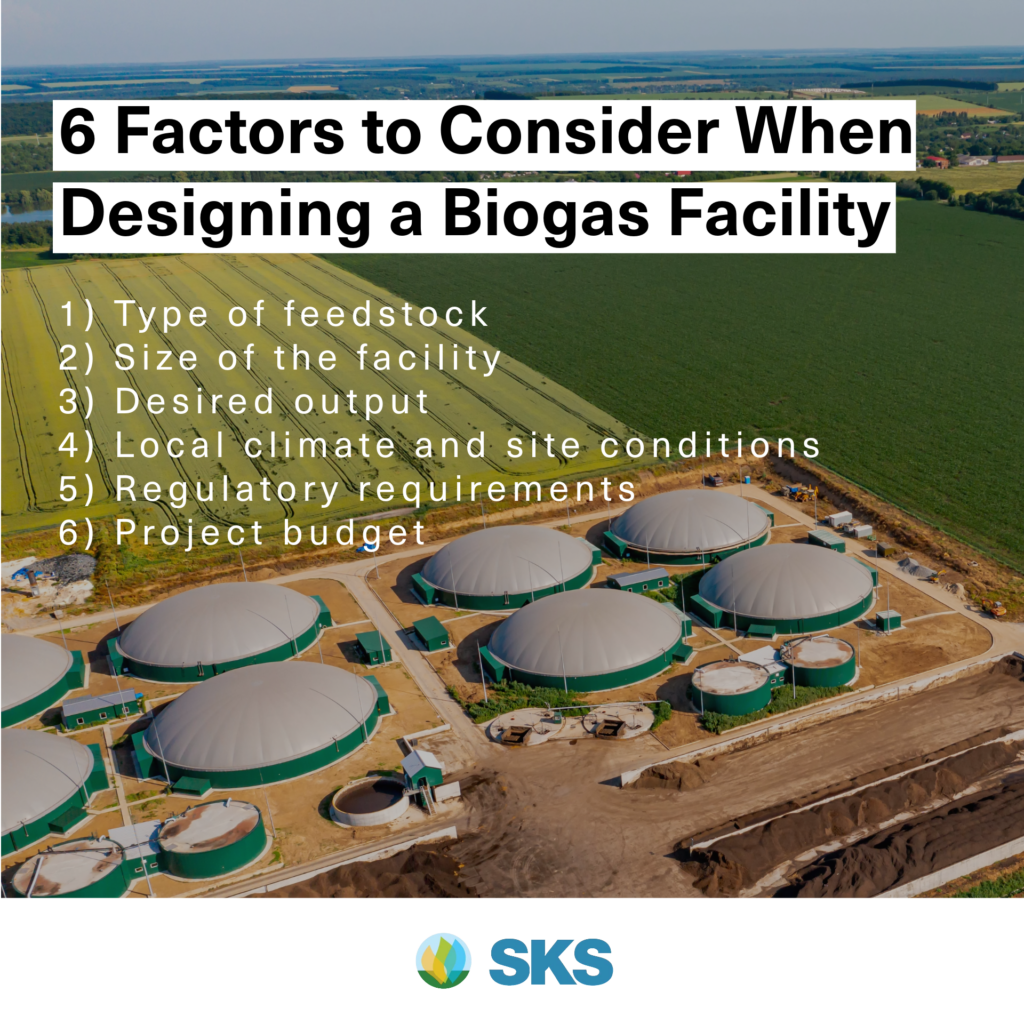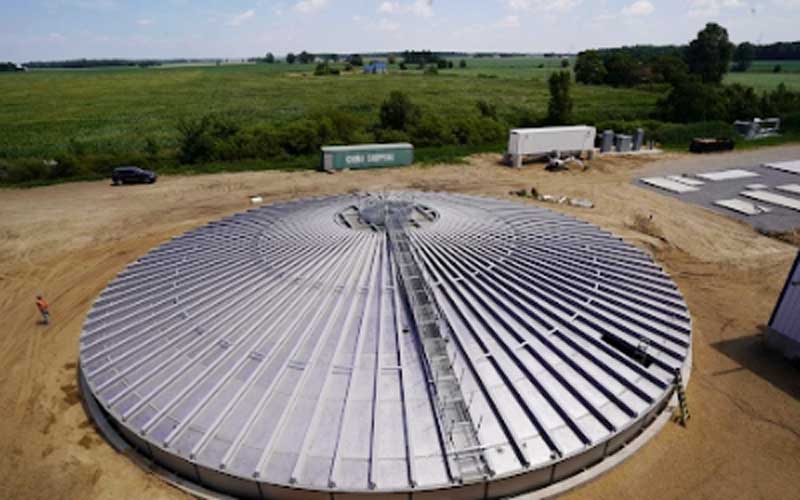Anaerobic digestion is a process that converts organic matter into biogas, a renewable energy source that can be used to generate electricity, heat, or transportation fuel. Biogas facilities can be used to process a variety of organic materials, including animal manure, food waste, and wastewater sludge. Now that we have a basic understanding of biogas and biogas facilities, let’s take a look at some of the key considerations that need to be taken into account when designing a biogas facility.
6 Factors to Consider When Designing a Biogas Facility
The design of a biogas facility is important for ensuring its efficiency and profitability. There are a number of factors to consider when designing a biogas facility:
Type of feedstock
The type of feedstock used to feed the digester will dictate the type of digester technology. For example, readily biodegradable substrates with low total suspended solids (TSS) may be better suited for a high-rate digestion process with retention times of only a few hours. Other feedstocks, however, will require longer times to break down more complex compounds. Depending on the treatment requirements, regulations, and required effluent quality, this can take up to 80 days.
Other considerations for the feedstock include:
- Micronutrients
- Macronutrients
- Rheology
- Compounds toxic to anaerobic biomass
- Influent temperature
- pH
- Buffering capacity
All of these feedstock considerations contribute to the selection of the digester technology. Some of the more common types of anaerobic digesters are:
- Continuously stirred tank reactor (CSTR)
- Plug flow
- Two-stage
- Contact reactor
- Fixed film
- Upflow anaerobic sludge blanket (UASB)
- Horizontal baffle
- Bulk volume fermenter
Each type of anaerobic digester has its own advantages and disadvantages, which impact whether it is a good choice for a particular biogas facility.
Size of the facility
The size of a biogas facility is determined by the desired output (energy production or effluent quality) and the solids retention time (SRT) required to achieve that output. The optimal digester size and point of diminishing return can be determined by plotting SRT with the desired performance.
The first step in determining the overall capital cost of a biogas facility is to select the digester technology and size the digester based on influent parameters. This requires an understanding of the relationship between the hydraulic retention time (HRT) and the SRT, digester loading, the food-to-microorganism (F/M) ratio, and any required pre-treatment for the digester to operate as intended.
Desired output
The desired output of the facility, or treatment goals, will also influence the design. These goals will be dictated by disposal methodology of the digestate, regulatory compliance requirements, operating expenses, and capital expenses, to name a few. Desired outputs can include energy production, pathogen reduction, pretreatment for subsequent treatment and beneficial reuse, and odor control.
Local climate and site conditions
The local climate and the condition of the project site can have a big impact on the design of the digester facility. Climate considerations are critical for determining things like the need for insulation, heating requirements of the digester, and biogas management strategies.
Site conditions, such as soil bearing capacity, groundwater, seismic conditions, and environmental considerations can introduce complexity during the construction phase.
Regulatory requirements
The biogas plant must comply with all applicable regulations dictated by the jurisdiction having authority (JHA). It is important to understand these requirements, as they can dictate the need for costly infrastructure and carry moratoriums and fines if not followed.
These requirements can vary from one local or county government to another, and may include road and driveway permits, stormwater permits, utilities, zoning, and local construction permits. Most states have reciprocity to manage air permits and National Pollution Discharge Elimination System (NPDES) permits.
All digesters will likely require some level of air permitting, but depending on the desired outputs, an NPDES permit to dispose of digestate or facility effluent may or may not be required. However, there may be other requirements that apply. For example, certain facilities, such as municipal digesters, may be required to follow federal guidelines such as EPA Part 503.
Additionally, each digester facility should be aware of potential requirements regarding OSHA’s Process Safety Management of Highly Hazardous Chemicals; Explosives and Blasting Agents Standard (PSM), 29 CFR 1910.119.
Project budget
The project’s capital expenditure (CapEx) and operating expenditure (OpEx) budgets will determine the size and complexity of the biogas plant that can be built, as well as its ability to meet the desired outputs. It is essential to have the ability to project and forecast CapEx and OpEx, potential revenue from the monetization of renewable energy and environmental attributes, and the cost of regulatory compliance to develop a successful business plan, of which the budget is only one part.
Having covered the key factors that affect the design of a biogas facility, let’s now take a closer look at the main features of designing a biogas digester.

Main Features of Designing Biogas Digesters
Heating
The temperature of the digester is important for the anaerobic digestion process. The temperature for most digesters is between 95 – 131 degrees Fahrenheit (35-55 degrees Celsius) depending whether the digester is mesophilic or thermophilic.
All digesters heat naturally as a byproduct of the fermentation process. This is called natural heating. However, this heat is not available until the digester has been seeded and the anaerobic process is functioning. If the natural heating requires supplementation, external heat sources can be used, such as hot water heat exchangers or steam injection. This is called artificial heating.
Mixing
Mixing is important to ensure that the feedstock is evenly distributed throughout the digester and that the biogas is produced evenly.
There are four main methods of mixing in biogas digesters:
- Mechanical mixing: This is done by using a mechanical device, such as a paddle mixer, turbine mixer, or helical ribbon mixer. Mechanical mixers are the most common type of mixing system used in biogas digesters.
- Gas mixing: This is done by injecting gas into the digester. The gas bubbles help to mix the feedstock and also provide oxygen for the anaerobic bacteria.
- Jet mixing: This is done by injecting a high-pressure stream of water into the digester. The water jets help to mix the feedstock and also remove any solids that may be floating on the surface.
- Vertical linear mixing: This is done by using a device that moves up and down in the digester. The vertical linear mixer helps to mix the feedstock and also break up any clumps that may form.
Tanks
The digester tank is the vessel where the anaerobic digestion process takes place. The tank must be made of a material that is resistant to the corrosive gasses produced by the digestion process.
The most common materials used for digester tanks are:
- Concrete: Concrete tanks are the most durable, but they are also the most expensive.
- Steel: Steel tanks are less expensive than concrete tanks, but they can be more susceptible to corrosion if not designed properly.
- Lined earthen: These are essentially covered lagoons. They usually offer the lowest cost per gallon of tank volume, but they are not suitable if groundwater is an issue.
Pumping
Pumping is used to transfer the feedstock in and out of the digester. The pumping system must be able to handle the high viscosity of the feedstock and the corrosive gasses produced by the digestion process. The rheology of each feedstock will need to be considered.

When designing a biogas digester, there are multiple types of pumps to consider. Common pumps include: open vaned centrifugal pumps, rotary lobe pumps, hose pumps, and piston pumps. These pumps are selected depending on the flow, total dynamic head, and rheology requirements of the material being conveyed.
Roofs & Covers
The roof or cover of the digester protects it from the elements and prevents the escape of biogas. It must be made of a material that is resistant to the corrosive gasses produced by the digestion process. The material of the roof or cover will depend on the type of digester technology, the size of the digester, the local climate, and budget limitations. Some common roof and cover designs used include fixed & floating, dual membrane, and gas bladder holders.

Process Control
Process control is used to monitor and regulate the conditions in the digester, such as temperature, pH, and mixing. This is important for ensuring efficient operation and high-quality biogas production.
The most common way to control the conditions in the digester is by using a computer-based system. The computer system monitors the conditions in the digester and makes adjustments to the heating, mixing, and pumping systems as needed.
The complexity of the process controls depends on the digester technology. Some digesters require complex controls that need to be operated by seasoned operators with lab skills to prevent the digester from “souring” in only a few hours. Other digesters can be operated with relatively simple controls that can be monitored remotely with a few instruments using a programmable logic controller (PLC).
How SKS Can Help You Design Your Biogas Facility
SKS is a leading provider of customized biogas facilities that meet the specific needs of our clients. We understand that no two projects are alike, which is why we take the time to fully understand your goals and objectives before designing a facility that is right for you.
We avoid cookie-cutter solutions and instead evaluate and assess your needs before determining the equipment and design that will deliver the optimal solution for maximizing potential economics while addressing your growth and sustainability objectives.
Here are some of the benefits of working with SKS to customize your biogas facility:
- We have decades of experience in the biogas industry, and we have a deep understanding of the different factors that need to be considered when designing a successful facility.
- We have a team of engineers who are experts in organic waste, anaerobic digestion, and biogas technology, and we are committed to providing you with the best possible service.
- We are flexible and adaptable, and we are always willing to work with you to find a solution that meets your specific needs.
- We are technology agnostic and, as digester operators ourselves, we understand the long term operational needs of each facility we design.
- Our team of engineers, project managers, and investment professionals have the know-how to build an optimized biogas facility that delivers profitability and investment returns.
If you are considering building a biogas facility, SKS is the partner you can trust to help you every step of the way. We will work with you to design a facility that is customized to your specific needs, and we will provide you with the support you need to ensure the success of your project.
To learn more about how we can help you customize your biogas facility, please reach out to the SKS team. We would be happy to answer any questions you have.
